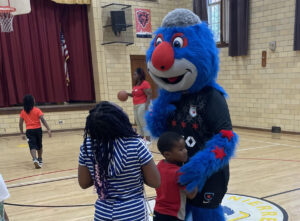Fun as an organizational value
Fun is pretty universal, and the unifying power of having fun together is the foundation for our belief in the unifying power of sport and play. However, fun, sport, and play are all concepts that many see as belonging on a playground or in the realm of children, not in the workplace. For 16 years, Urban Initiatives has prioritized fun as one of our organizational values, not only for our youth, but for our staff as well. Although fun in the workplace may look different than it did when we were children, it remains a vital part of creating effective teams, pursuing our mission, and maintaining a healthy work environment. Regardless of whether you’re an employer, a teacher, a coach or a business owner, there are benefits to creating fun environments for those around you.
At Urban Initiatives, fun and inclusion are two of our core values. We believe in finding as much enjoyment in work as we do in play. This means that we intentionally and strategically create fun environments that include everyone throughout our work. We know that fun and the power of play has the ability to break down barriers and build team cohesion. This isn’t just an approach we take with our participants, but is something that we prioritize with every staff member and stakeholder we have the privilege to work alongside.
When speaking to anyone who is connected to Urban Initiatives, whether it is a participant, staff member, or a stakeholder, they will tell you that it is the fun that drew them in to joining our team. Allowing space for fun is something that is valued by all members of our team, and constantly supported by leaders within our organization. There is some aspect of fun in all of our day-to-day operations. We start meetings with an energizer, icebreaker, or celebration; we allow time to celebrate successes; and we create space for creativity. Most importantly, we set aside structured time for fun by planning events that allow for our team members to connect. We have retreats for our students and for our staff, an appreciation party for our coaches and families, and a number of different fun and engaging opportunities for board members and others who are connected to our network.
Fun environments are not only good for team members and their personal satisfaction, but studies suggest that fun is also a tool leading to greater levels of productivity, lower levels of absenteeism, and greater job satisfaction1. Whether you are a student, volunteer, or employee, we all look to find a level of joy and connectedness with what we are a part of. This makes perfect sense; no one enjoys “going through the motions” every day. Additionally, studies have shown that when fun environments exist, they actually help decrease the number of interpersonal conflicts that arise.2 Focusing on making an environment more inclusive and fun creates opportunities for team members to learn more about each other. At UI, we understand that every member of our team is investing significant time, energy, and resources to help us further our mission. This is why we invest so many of our resources into ensuring we are providing them with an inclusive and fun environment. We truly believe that our staff and stakeholders are significant assets and that when they are happy, we are able to do our best work.
How you can create fun environments
The first key to creating a fun environment is to make sure that those who are a part of the environment feel welcome, included, and safe to be themselves. By doing this, you initiate and lead the charge in creating a fun environment. In some ways, workplace policies and rules can help promote inclusivity. However, it helps team members feel valued when they have a role in establishing some of the expectations for team dynamics. By allowing them to contribute, you are letting them know that their opinion is wanted and that it matters.
Having a basic understanding of the people who are a part of your environment is essential to making sure your efforts will yield enjoyment for them. Effective leaders know their personnel, teachers know their students, and coaches know their players. Using this knowledge to intentionally establish a culture and an environment that is inclusive of them is proven to be one of the most effective strategies.3 When team members better understand one another, it makes it easier and more efficient for them to collaborate together.
Another important key to creating a fun environment is ensuring you make the time for it. Team building exercises are always an easy way to incorporate fun into your environment. Team members are given the chance to build different skills while simultaneously learning about the strengths, skills, and talents of those around them. You can also make time for fun by planning other outings and social events for your team to attend or just setting aside 10 minutes each week to do an icebreaker at a meeting. Consider delegating the planning responsibilities to various members of the group, so that everyone feels responsible for creating a positive culture.
The last key is this: building a positive and productive culture of fun will take time and that is okay. Making environments fun doesn’t happen overnight. You have to commit to changing the environment. When incorporating new ideas, gather feedback to analyze whether or not the strategies being implemented are having a positive effect. As time passes, don’t be afraid to end old initiatives and start new ones. Allow the other members of the environment to take responsibility for building a positive culture. This will give them the opportunity to be creative and add to their sense of belonging and inclusivity. There is no one size fits all approach to creating fun environments. It will look different from company to company, from school to school, from team to team, and even from person to person. Nevertheless, the benefits are worth it.



